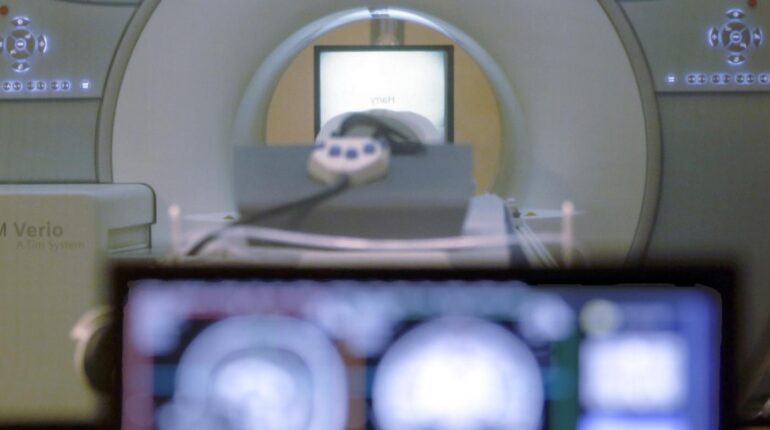📌 Man dies after metal chain pulls him into MRI machine, sparking safety investigation

Posted 20 July 2025 by: Admin
Fatal MRI Accident Rocks Nassau County Medical Facility
A routine medical procedure turned deadly this week when a 61-year-old man was pulled into an MRI machine at Nassau Open MRI in Westbury, New York. The victim died Thursday from injuries sustained during the Wednesday incident, sending shockwaves through the medical community.
Nassau County Police launched an immediate investigation into the fatal accident that has exposed critical safety concerns at the imaging facility. The man’s death occurred just one day after the traumatic incident, underscoring the devastating severity of his injuries.
The tragedy unfolded while an MRI scan was actively in progress. Hospital personnel and investigators are now piecing together the exact sequence of events that led to this unprecedented medical emergency.
Nassau Open MRI has remained silent since the incident, declining to respond to media requests for comment. The facility’s lack of communication has intensified scrutiny as authorities work to determine what safety protocols may have failed.
This marks a rare but catastrophic example of MRI-related fatalities, highlighting the potentially lethal consequences when magnetic safety measures break down. The victim’s family now faces the unthinkable loss of a loved one during what should have been a routine diagnostic procedure.
Police continue their investigation as questions mount about how such a preventable tragedy could occur in a modern medical facility equipped with established safety protocols.
The Deadly Chain: How Metal Became A Fatal Magnet
The investigation has now revealed the critical detail that sealed the victim’s fate: a large metallic chain around his neck. This seemingly innocent piece of jewelry transformed into a deadly weapon the moment he entered the MRI room.
Police reports confirm the scan was already in progress when the 61-year-old man stepped into the magnetic field. The powerful forces immediately seized the metal chain, dragging him violently toward the machine’s core with unstoppable force.
The chain acted as a magnetic anchor, pulling the victim directly into the MRI apparatus. The impact triggered an immediate medical episode that would prove fatal within 24 hours.
Witnesses described the horrifying speed at which the magnetic field captured the metal object. The man had no time to react or escape once the chain made contact with the machine’s powerful electromagnetic forces.
The sequence of events highlights a catastrophic breakdown in safety protocols. Standard procedure requires removing all metallic objects before entering any MRI environment, yet somehow this critical safety barrier failed completely.
Medical experts emphasize that MRI machines generate magnetic fields up to 60,000 times stronger than Earth’s natural magnetism. Any ferromagnetic material becomes a projectile with lethal potential.
The victim’s chain transformed from personal accessory to instrument of death in seconds, demonstrating how quickly routine medical procedures can turn fatal when safety measures collapse.
MRI Magnetic Fields: The Hidden Dangers In Medical Technology
This tragic death exposes a universal threat lurking within every MRI facility. The victim’s chain represents just one of countless metallic objects that transform into lethal weapons inside these medical chambers.
The Food and Drug Administration has repeatedly warned healthcare providers about MRI machines’ strong, static magnetic fields that create severe physical hazards. These electromagnetic forces don’t discriminate between jewelry, medical equipment, or everyday items.
Cell phones, keys, and oxygen tanks become projectiles with devastating potential once they enter the magnetic field. The FDA specifically identifies these common objects as serious threats to both patients and medical professionals working nearby.
The magnetic pull operates with relentless force, offering no second chances or escape routes. Objects weighing several pounds can accelerate toward the machine’s core at tremendous speeds, striking anyone in their path.
Medical staff face constant danger from ferromagnetic items that patients inadvertently carry into MRI rooms. A forgotten coin, a metal belt buckle, or even surgical instruments can become deadly projectiles within seconds of exposure to the magnetic field.
The electromagnetic forces generated by MRI machines create an invisible danger zone where ordinary objects defy human control. Once metal enters this field, physics takes over with potentially fatal consequences.
Healthcare facilities nationwide now confront the same vulnerability that claimed this Nassau County victim’s life. The magnetic field that enables life-saving diagnoses simultaneously poses an ever-present threat to human safety.
Safety Protocols Under Scrutiny: The Critical Screening Failure
This vulnerability stems from a fundamental breakdown in mandatory safety procedures that every medical facility must enforce. The Nassau County tragedy exposes systematic failures in the most basic protective measures.
The FDA mandates uncompromising standards for MRI safety protocols. Careful screening of people and objects entering the MR environment is critical to ensure nothing enters the magnet area that may become a projectile, according to federal regulations.
This screening requirement isn’t a suggestion—it’s a life-or-death mandate that Nassau Open MRI apparently failed to implement effectively. The victim’s large metallic chain should never have passed through any competent security checkpoint.
Medical facilities must create multiple barriers between patients and magnetic fields. Metal detectors, visual inspections, and verbal confirmations form the standard defense against ferromagnetic dangers.
Nassau Open MRI has maintained complete silence since the incident, refusing to respond to media inquiries about their safety procedures. This institutional silence raises serious questions about accountability and transparency during the ongoing police investigation.
The facility’s lack of response contrasts sharply with the critical importance the FDA places on preventing exactly this type of incident. Every MRI center operates under the same federal safety requirements that demand rigorous object screening.
Police investigators now examine whether proper protocols existed at Nassau Open MRI and why they failed so catastrophically. The victim’s death transforms a routine medical procedure into a criminal investigation questioning fundamental safety practices throughout the medical imaging industry.




















